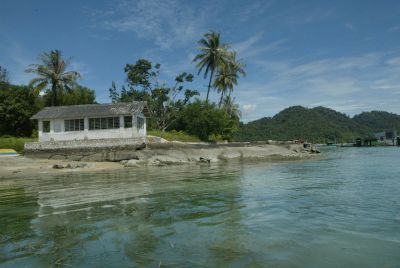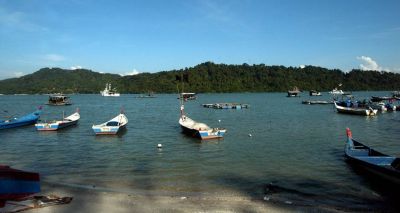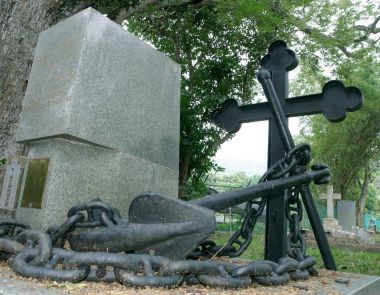 Many tales to tell: Despite its potential today, Jerejak is viewed by many as simply an island where people were once sent to because they were either lepers or hardened criminals.
Many tales to tell: Despite its potential today, Jerejak is viewed by many as simply an island where people were once sent to because they were either lepers or hardened criminals. IT IS an island that is just a short ferry hop away. Along the promenade fronting the very busy Queensbay Mall — flanked by the Penang Bridge to the left and the almost completed Second Bridge to the right — one can practically reach out and touch the island.
Almost every Penangite is aware of Pulau Jerejak but among the older generations, it is spoken about in whispers. Even among the young, few can find good reason to go over to the island, even though there is now a recreactional and spa facility there.
One can imagine how the Singaporeans might look at this 362ha island and transform it into another Sentosa island. But for Penangites, perhaps the stigma associated with the island still remains strong after all these years.
Many of us still associate Jerejak with the leper colony and later on, as a detention centre. It is simply viewed as an island where people were sent away to be out of sight, and out of mind, either because they were lepers or because they were hardened criminals.
Construction of the leper colony started in 1868 and the centre was opened in 1871. The patients came from the Straits Settlements but in the 1960s, the centre was closed down.
I came across an interesting account of Jerejak, once named the Leper Island, by George Bilainkin, the British editor of The Straits Echo.
He recalled “the sound of the Tamil lepers’ band” when he arrived to witness the consecration of a Hindu temple for the islanders there.
It must be understood that leprosy was a much dreaded disease at that time and due to a lack of understanding, the patients were treated as “outcasts”. We still recall stories of how the lepers had to wear bells so that the people could hear them coming and move aside.
 A short ferry hop away: Pulau Jerejak seen from the Bayan Lepas coastal road.
A short ferry hop away: Pulau Jerejak seen from the Bayan Lepas coastal road. Today, of course, we know that leprosy is not a contagious disease and cannot spread through contact.
But at that time, all leprosy patients were literally isolated and kept away from society, with little forgiveness and understanding from the public.
“Much could be said, of course, of the revolting side of the affliction, consisting as it does of the putrefaction of the extremities. It affects the head, hands and all parts of the body. If the disease is caught in the early stages, the treatment may bring about a cure,” wrote Bilainkin.
But what caught his attention were an English woman and her Australian husband who had dedicated their life to care for the lepers.
When Bilainkin met the couple, they spoke of having to chase away snakes which often entered their compound, including “one that measured 16 feet”.
They had lived in Malaya for 10 years then and even though work had kept them busy, loneliness crept into their life, according to Bilainkin in his book, Hail Penang!
The leprosarium was closed in 1960s and the inmates were transferred to the Sungai Buloh Leper Settlement/Leprosarium. This has also closed down and today, people go to that part of Sungai Buloh mainly to buy plants and other nursery items.
But after the lepers left the island, the sad story continued with the opening of the Jerejak Rehabilitation Centre as a maximum security prison, earning the island the moniker, the Alcatraz of Penang.
The prison was only closed in August 1993.
 In remembr ance: The monument for the Russian sailors, who died when their cruiser ‘Zhemchug’ was sunk by the Germans in the Battle of Penang, at the Western Road Christian cemetary.
In remembr ance: The monument for the Russian sailors, who died when their cruiser ‘Zhemchug’ was sunk by the Germans in the Battle of Penang, at the Western Road Christian cemetary. Because it was a penal island, security was tight and entry was forbidden except on special grounds. Which is why I am thankful to lawyer Karpal Singh for bringing me along to visit Pulau Jerejak.
I had joined The Star office in Pitt Street, Penang then and was covering Karpal both as a lawyer and politician.
One day, I told him that I had never visited the island. He offered me an opportunity to visit the place on condition that I carry his bags, posing as an assistant from his legal firm.
Interestingly, the boat that was to ferry us across broke down and we had to use another boat, loaded with watermelons, for the inmates of the centre.
In the boat were a few inmates, who happily cut the fruits and offered them to us as we travelled to the island.
On the island, we had to wait at the visitors section, where inmates could meet their relatives or lawyers. We later adjourned to an office — and there I saw what must be the most perfect office administrator.
Each time, the officer stood up and walked off, the inmate would push the seat in. He would carry out this task without stop, like a robot, in a mechanical fashion but always with a smile on his face.
But like the infamous Alcatraz of San Francisco, Jerejak also had its list of attempted escapes. Until its closure in 1993, there were seven inmates who reportedly escaped.
In the racial riots of May 13, 1969, those who were caught taking part were arrested and detained in Jerejak.
But I do wish I could come up with some stories about the island that would bring smiles to readers.
Much earlier on, Jerejak was the scene of a fierce sea battle between the Russians and the Germans in what is dubbed as the Battle of Penang on Oct 28, 1914.
A memorial was built on the island for two crew members of the Imperial Russian Navy who died when their cruiser Zhemchug was sunk by the cruiser SMS Emden belonging to the Germans. There is also a monument for the Russian sailors in the Western Road Christian cemetery.
Just outside the Penang Museum is an anchor which belonged to the French destroyer Mousquet, which stands as a memorial to the dramatic sea battle.
Not many Penangites, including the older ones, are aware of the sea battle which saw the Mousquet sinking off Muka Head after being attacked by the Germans.
There is no mention of this historic event in our history schools, at primary and secondary level, and nor did I learn about this as a history student in university.
It was only much later, as a working adult with a great interest in the history of Penang, that I picked up details of this historic event.
The Battle of Penang, written by J.R. Robertson, is certainly one of the best works available.
The book offers a detailed story of how the global imperial forces of Russian, French and German warships fought each other in Penang in 1914.
Jerejak has so many stories to tell. They may not be happy tales but Penangites must know more about this island.
It was also reportedly Captain Francis Light’s first stop before he landed on Penang island proper. That itself is a story worth exploring.





